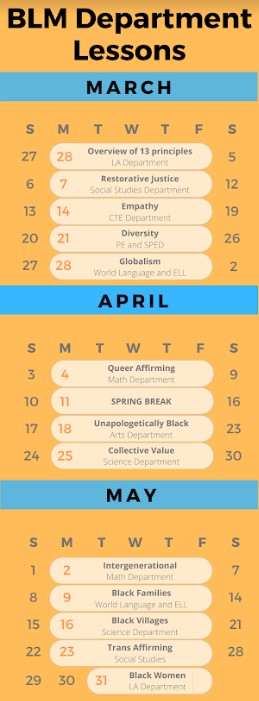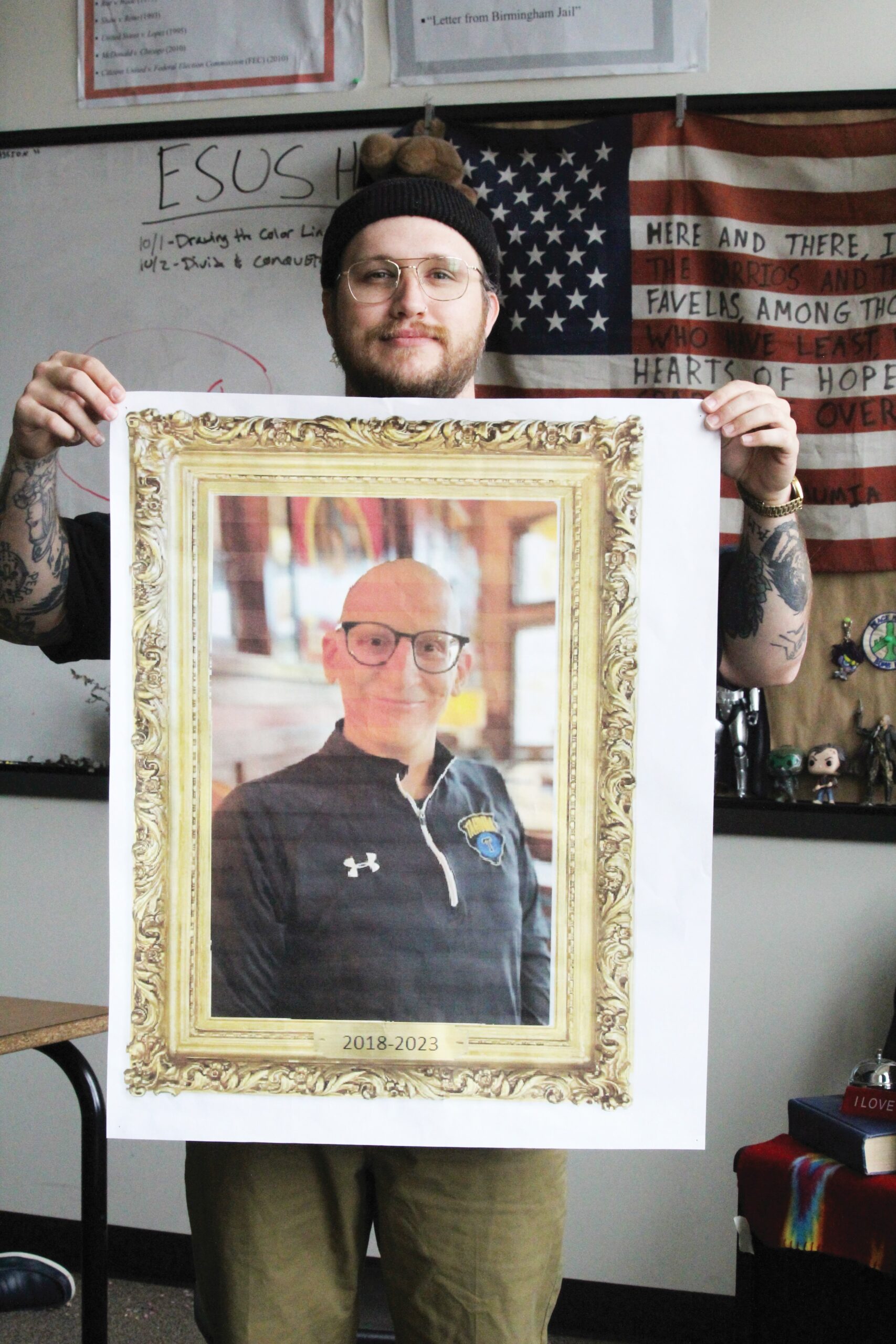In working toward anti-racism, inclusivity, and a diverse curriculum, Roosevelt High School engaged the LaJuana Johnson Leadership & Development Group (LJLDG) for the 2020-21 school year. Funded in part by the Roosevelt Foundation, LaJuana Johnson was hired as a racial equity and anti-racism assessment and training consultant to help guide Roosevelt toward institutional change.
The Roosevelt Building Leadership Team (BLT) and the then-principal, Kristina Rodgers, envisioned working with LJLDG in distinct phases over three years with results and plans to be reviewed at the beginning of each year.
In October 2021, the Roosevelt High School Racial Equity Assessment – a report by LJLDG – summarized the first year of LJLDG’s work. By November, the Foundation was prepared to fund another year, explains Pam Eshelman, president of the Roosevelt Foundation Board. However, the new principal, HkwauaQueJol Hollins, “felt that [Johnson’s] work could be done with district employees instead of funding [LJLDG]. So, [Hollins] was not supportive of that program,” explains Eshelman.
Without Hollins’ support, BLT “decided to reach out personally to the Roosevelt Foundation,” says Jordana Hoyt, social studies teacher and BLT co-chair. The Foundation made it clear that a BLT proposal was necessary to continue funding the services of LJLDG.
In January, a subcommittee of BLT collaborated with Johnson to create and submit a Scope of Work proposal to the Foundation, summarizing the goals of continuing to work with LJLDG.
However, Hoyt explains that while “The Foundation was more than willing to fund [LJLDG], … they spoke with Mr. Hollins who felt that that Foundation money should be allotted to other things.” And so, funding for an additional year of collaboration with LJLDG was not approved.
Johnson elaborates, “From my understanding, [Hollins] wasn’t completely bought in, [he] really felt like the district was doing a big push on … anti-racism — they had a whole new initiative that the district staff were doing.”
District personnel focused on anti-racism include the Department of Racial Equity Advancement — a “capacity building department that supports racial equity leadership development across individuals, teams, and departments — both in school buildings and at Central Office,” explains the Seattle Public Schools website.
Unable to continue racial equity work under Johnson’s guidance this year, Maya McKenzie, counseling secretary and BLT co-chair, says, “I feel like a lot of the work we’ve been doing has been stalled.”
The Development of All-Staff Race Talks
With Johnson’s support, the 2020-21 school year saw the beginning of All-Staff Race Talks at Roosevelt. According to Amy Noji, language arts teacher and Teacher Leadership Cadre member, “Race talks are meant to help staff members … become more comfortable talking about race,” specifically in affinity groups, or discussion groups based on common racial or ethnic identity.
In staff feedback, Johnson recounts how many staff were beginning to develop relationships with colleagues outside of their department. “And that stuck in my mind because … this work is about connection and community and holding each other accountable in the work,” she says. “If you don’t know each other, it’s harder to communicate, it’s harder to collaborate, it’s harder to create community, and it’s harder to create accountability. So that’s why I’m a big believer of the brave conversations.”
Last school year, All-Staff Race Talks were held twice a month and led by facilitators trained by Johnson during staff’s weekly Professional Development days. Holly Howe, language arts teacher and TLC member, explains that race talks “were twice a month last year because the administration … felt that this was so strong a need in our school.”
This year, the administration did not offer a second day, and Race Talks have been held instead once a month.
Reflecting on last year, Noji says, “I feel like we made progress and we were making progress. Even though people were tired with online learning and struggling with their own stuff — there was awareness. There was a shift, there [was an] understanding [of] students on a deeper level.”
Roosevelt Staff Take the Reins:
Without LJLDG’s services this year, the TLC and facilitators have been leading race talks independently. “Since we’re not experts, we don’t really have a clear plan,” Howe says. “So we’ve been trying to come up with different ways to go about it. So it’s been sort of sporadic in how we’ve been doing it.”
For the remainder of the year, staff have been reading “Me and White Supremacy,” by Layla Saad. “It’s a month-long journey through assessing your own racism and where you intersect with it. And then also, not just that, but white supremacy cultural values, and white privilege,” explains Howe.
The book is structured as a 28-day-series of short readings and journal prompts, but the staff has been digesting it more slowly. According to facilitator-submitted data, about 50% of staff regularly attend All-Staff Race Talks. 35% attend sometimes, and 15% rarely or never attend.

Black Lives Matter Lessons are Extended
The February 2022 Black Lives Matter lessons were marked by student panelists from the Black Student Union. On the staff side, building leaders also collaborated to organize in-class, once weekly, department-sponsored lessons on the 13 Guiding Principles of BLM, extending throughout the spring.
Howe explains that trained facilitators from the All-Staff Race Talks met with each department and “supported them creating lessons about a particular Black Lives Matter principle.” So, Hoyt says, “All departments got to create their own lesson based on a Black Lives Matter principle in a way that felt authentic to their discipline and to them.”
Howe says this structure allowed teachers to “take their own responsibility for creating the safe and brave spaces in their classrooms. … So it was moving from just talking about and experiencing a safe space in our Race Talks to creating one in their own classroom.”
The future of the structure of BLM lessons will depend on prospective leadership of the Instructional Council (department chairs), BLT, TLC, and administration, explains Hoyt.
Looking to the future, McKenzie stresses the importance of intentionality in the lessons, “I wanna see that intrinsic motivation to be like, ‘This is gonna make my classroom better. This is gonna make me a more effective teacher and create a space where all my students feel welcome and supported,’” she says. “And I want to see that across the building, not just in pockets.”
Reforming BLT Procedures
One goal outlined in LJLDG’s RHS Equity Report is to reform building procedures and practices — a primary burden on BLT and administration.
Upon reflection, Hoyt says BLT has “done a ton of foundational work this year, and it seems like we haven’t gotten that much done in terms of the documents and in terms of changing practices, because we have been analyzing everything with that equity lens.” She continues, “But now the task of BLT, I think, is to really enact and create basically processes that really embody the values we’ve discussed a lot this year.”
BLT responsibilities include organizing PD for staff, developing the Continuous School Improvement Plan, and budgeting for the Discretionary Fund.
In BLT procedures this year, McKenzie explains that a racial equity lens has been incorporated as the base level of BLT work, “So even starting from the norms that we have in every meeting and making sure we are representing every voice that we can.”
BLT bylaws, or guidelines that organize BLT procedures, are annually reviewed and approved by staff in a vote. This year, “The budget committee bylaws were edited to create opportunities for staff to make funding requests, and the district racial equity tool was incorporated into the budgeting process. These measures were approved to ensure that the needs of students furthest from educational justice were centered,” explains McKenzie.
Looking to the Future
In planning PD for staff next year, McKenzie explains the challenges with an administration in flux, “It’s really challenging when we have a new principal who is just appointed because … we could come up with this great PD plan of what we want staff to participate in, like our [All-Staff Race Talks]. But if we don’t have a principal who’s on board with that, it’ll stall.”
BLT leaders hope to meet with the new 2022-23 principal, Tami Brewer, to promptly begin planning for next year. Brewer points to her experience with diversity: “I’m comfortable in a space where I’m not the majority, and I’m comfortable with having lots of experiences with a broad range of cultures from my families and from my students.”
Brewer also emphasizes the importance of effective leadership, “It also means all elements of leadership, including student leadership. So I strongly believe in student voice.” Brewer also stresses, “Equity doesn’t happen without making that a true intentional part of the work.”



